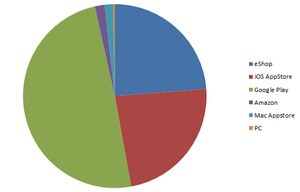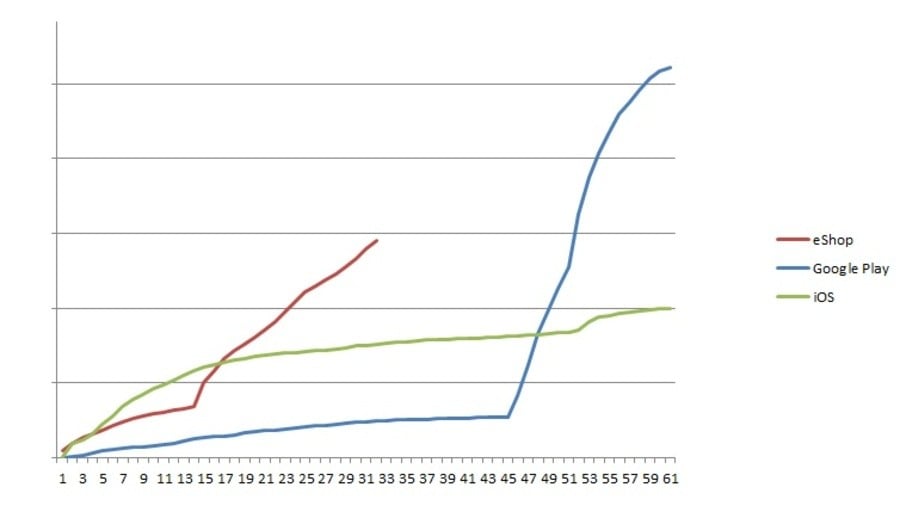
The video game industry is in the middle of, arguably, its most unstable period — the landscape is evolving almost too quickly to track. Nintendo, Sony and Microsoft are currently sticking to the course as constants, in general maintaining well-worn business practices while attempting to adjust to new challenges. The biggest impact on current gaming is arguably from downloads, which is an area becoming more varied as time passes — we have the iOS and Google Play marketplaces, with a variety of phones, tablets, TV and handheld consoles all attempting to grab a share of those enormous user-bases.
The challenge for Nintendo and its console manufacturing contemporaries is to offer a download platform still attractive in the age of free or 99 cent games. The iOS and Google stores follow a different pricing policy from what we may think of as a "conventional" structure for platform companies like Nintendo — that term alone could spark a series of debates — with many games costing less than a chocolate bar and relying on big sales numbers, micro-transactions, in-game advertisements or a mixture of all three. When games arrive on a platform such as the 3DS eShop from a smartphone equivalent, meanwhile, one of the first comparisons made is with price, and often the Nintendo platform comes with a higher cost of entry.
In this article our focus is on the 3DS eShop — the Wii U eShop's rivals and competitors form a slightly different dynamic with, for example, Steam on PC — and today's revelations from Gunman Clive developer/publisher Bertil Hörberg, who took to NeoGAF to outline sales across iOS, Android, 3DS eShop and other platforms. While it can be assumed that iOS and Android Play are the platforms that make small indie studios rich and successful — an argument that's becoming more common — Hörberg's experiences show that the eShop is more than holding its own, and actually outstripping sales on the Apple equivalent.

It should be noted that Hörberg was careful not to give firm sales figures, which in all likelihood would violate NDAs (non-disclosure agreements) on the related platforms, but we can assume solid overall numbers from the following statement — "the total sales are still not massive and I'm hardly wealthy yet, but I've been well rewarded for the time put in and it's made a very healthy profit considering how little I've spent on it." He also states that sales on various PC and Mac services (not including Steam) have been relatively low — less than 200 on PC — and the pie chart alongside this text shows that it's the portable markets bringing the most success.
As that same pie-chart shows, and as Hörberg has explained, 3DS eShop sales have already surpassed the lifetime sales on iOS, despite the title being on 3DS just a month, and only two and a half weeks in North America — it's been available on iOS since April 2012. Google Play is the undoubted star, with its overall figure a "long way off" for the eShop release, though consistent sales on 3DS may see it get close in the long term. Below is the line graph from our original article which shows the first two months of equivalent sales on each platform, of which the 3DS eShop is only halfway through the period.

This graph demonstrates multiple key points. On the one hand, it shows the power that exposure and front page marketing can have on Google Play, with the title's sharp increase a result of being "featured" and then being discounted for a spell — sales increased, in Hörberg's words, 10,000% over a two week period. It did make the iTunes New and Noteworthy list for around two weeks in some countries, yet despite an increase it didn't hit the heights of the Google equivalent.
What's interesting about the title's strong sales on 3DS is that it wasn't heavily promoted on the eShop. It didn't get a prominent front page slot when released — though would have scrolled through as a new release on the ticker-bar — and it has featured in category lists such as "5 Star Software" in some countries and in locations such as the UK as part of the "Winter Highlights for Nintendo 3DS" shelf. Yet its sales, especially since it arrived in North America, have been on a steady upward trajectory. Hörberg concluded his post with the following comments.
Obviously iOS is a much larger market and it might not be possible to become an overnight millionaire on the eShop, but for a small game with no marketing and little prerelease hype it does feel like the eShop is a healthier market, and while it's received some promotion from Nintendo it doesn't seem to be as reliant on it. It could also be that the word of mouth is helping a bit more on the 3DS because of buttons etc, but overall the response for the smartphone versions was also very positive. The total sales are still not massive and I'm hardly wealthy yet, but I've been well rewarded for the time put in and it's made a very healthy profit considering how little I've spent on it. There's still no telling where the 3DS sales will end up, and the other versions are still selling, though not at a very impressive pace.
The comments about the healthy state of the eShop market from a small developer such as this will be music to the ears of Nintendo, and as some of the Nintendo Life community has already pointed out is perhaps indicative of the relative strength of Nintendo's digital platform business model. While Android and iOS are flooded with new entries on a weekly basis, with thousands of games competing for attention, the eShop still follows a licensing approach — developers are approved and, it seems, pay for development equipment and resources. It's a traditional model that Nintendo's no-doubt adapting to welcome indie developers; a balancing act between opening the gates to those that are interested, while still managing and controlling content.

This publishing model, for the immediate future at least, will mean that the current rate of releases across the four online stores will continue to be, roughly, between four and eight new downloads a week. While these games won't all be top-notch — as our review team can attest — some most certainly will be, and the realities of a smaller audience will be offset by greater visibility and a more reasonable volume of competition. Even without significant front-page presence, such is the weekly release schedule and overall game library that Gunman Clive has still earned attention and, importantly, sold a good number of copies; its budget price-point probably helped, it must be said.
Comparisons between Nintendo's eShop platforms and those from Google and Apple are often unreasonable, as they have entirely different structures. What is undeniable is that Nintendo is continually asked to justify its business model and methods for download games. It won't always hold up against the high-profile runaway hits on smartphones and tablets, but we should remember that for every smartphone millionaire developer, hundreds and maybe thousands have probably sold very few games. Gunman Clive gives us one example where Nintendo's approach is undeniably successful; this perhaps explains why a core group of committed developers — those such as WayForward Technologies, Renegade Kid and Shin'en Multimedia — keep coming back.





Comments 38
This is good news for Nintendo! Finally heading in the right direction!
Hear that?
That's the sound of the smartphone bubble about to burst....
My view
Improvements
1. No more 6000 sales bullcrap (Fixed long ago, DSiWare)
2. Stop dictating prices like a madman (Dunno when fixed)
3. Remove size limitations (3DS eShop)
4. Remove office space restrictions
5. Demos
How to increase the success
A. Cheaper devkits (Should still be more expensive then iOS though. Quality control)
B. More sales and some actual price cuts
C. Offer incentives for going online more like new tracks for MK7.
D. Make online multiplayer or some sort of connection a must for almost every game (EDIT: Presuming it fits)
@rayword45
That very last suggestion sounds very awful. I don't want bad tacked on online multiplayer to jack up the price. It would just be a burden on developers too.
I'm really glad to hear this. Hope the future stays bright for Nintendo's online stores.
Good news and extraordinarily well thought and well written.
@Retro_on_theGo That was worded poorly. Let me try to explain this.
Look at Super Mario 3D Land. That game needs no online (unless you think DLC is a good idea) so no problems. Many games fall under this like Paper Mario: Sticker Star, Dillon's Rolling Western, Kingdom Hearts 3D, etc;
But then look at games like Bomb Monkey, Ridge Racer and Star Fox 64 3D. No online leaderboards, no VS. multiplayer, nothing. Those games would've been a lot better with online included.
Doesn't it cost over $20,000 dollars to become ESRB-rated iirc? I think the game should've been at least $3 to help cover that cost. Amazing game tho. If it wasn't for the glowing review this site gave, I would've thought this was a cheap bad game. Boy was I wrong. But the developer does deserve to be rewarded.
Good read! Simply put: when it comes to games, I'm always going to prefer quality (eShop) over quantity (app store).
http://images3.wikia.nocookie.net/__cb20070518182104/egamia/images/e/ee/Official_Nintendo_Seal_of_Quality_%28Original%29.jpg
Not a surprise really. Seems to me that most people on iOS just download the free versions of a lot of these games and don't pay money for them. My girlfriend has an iPad with like 20+ 'games' she plays, and I doubt she has paid money for more than 3-4 of them.
@CrissCross87 A. I don't know the actual price, but $20000 seems far-fetched.
B. Games with a budget under $250000 or something like that get a discount
C. Supposedly, digitally distributed games get it at no cost (might not have started yet).
All ripped from Google.
EDIT: $2500 for big-budget, $800 for small, still way too freakin expensive. But yes, games on the eShop get no-cost ratings.
Demos for all games is something that would improve sales for all games. Many games I am hesitant to buy for fear of losing my money, and it doesn't help when I spent $10+ on a few games and quickly deleted them because they couldn't hold my interest. I find the prices fairly decent on the eShop, though I think sales and price cuts over time for certain titles.
I am extremely grateful to this site for offering consistent reviews on all eShop titles. They are a huge factor in whether or not I purchase a game and have saved me from many bad games that do not deserve my money.
Another reason why I hate IOS.
@rayword45 Good except D is a terrible idea...
Glad to hear it--Downloaded Gunman Clive last week, and it really is a great little game.
@Pikachupwnage Like I said, I meant where it would actually fit. I'm not asking for Cave Story to have online multiplayer. I am asking for Star Fox 64 3D and Ridge Racer to though.
You know what would really boost 3DS sales? A 3D Super Mario World for the "NINTENDO 3DS eShop". Now I don't mind the indie developers, but I am more a NINTENDO fan.
I always said that the 3DS eShop was a huge factor for me and it is !
@baba_944 Yeah... Your expectations suck.
Nintendo isn't going to invest loads of money into a high-profile Mario title to release it for $10 on the eShop.
Though if we do get anything related to Nintendo franchises, KID ICARUS SPIN-OFF WITH MAGNUS AND GAOL. That would be effing awesome.
@raywork45 I can dream can I? Lol.
Or what about a DK64 sequel?
I wouldn't be too surprised if they made a new Donkey Kong game and put it on the eShop.
And charged $40 for it and released it as a cart.
@rayword45 NINTENDO logic.
Quality over quantity.
But my only issue with the eShop comes from the Virtual Console, there is no real reason why their can not be a release a week considering that 4 systems catalogs are available. And if needed to get more to download then partner with Konami,Atari,SNK, and Bandai to get Turbo Grafx,Lynx,Neo Geo Pocket, and Wonderswan games up.
Please label your graphs.
Glad to hear! eShop is getting there!!
I really wouldn't read much into this. Nnooo's Pop game was more successful than its iPad and iPhone releases (WiiWare), but no one in their right
mind would say WiiWare is a superior platform for developers than iOS
@Bankai Nobody has said that yet as far as I can tell about the eShop.
But if you are willing to spend the cash on a devkit, your chances of getting noticed on the eShop are much, much higher. And there's a lack of terrible policies (unlike WiiWare)
Extremely pleased to hear this. Hopefully Nintendo is listening, too; you can have quality at a pocket money price. Gunman Clive is a worthy eShop title, and the cost seems appropriate for the length of the basic experience.
Cheap, quality titles do have a greater chance of being recognized on the eShop, so it isn't surprising to see they've done well on the eShop. Just like with their discount promo that jumped the game up 10,000% on Google Play, they can turn around and do the exact same thing to get into the Top 200 on the iOS Marketplace, as well.
@AbeVigoda Actually, people spend money on the iOS Marketplace. That's why developers flock to the service above and beyond the Android service.
I would love to have a demo for every game released on the eShop. I've probably wasted little over $15 on games I found unenjoyable or just ridiculously difficult. The star rating doesn't help me at all, because nearly every game, no matter how crappy it is gets at least a 3 stars universally.
As soon as I have access to the eShop, this will be a purchase of mine. I thought it was brilliant on iOS and would be an even better fit on a Nintendo product since it seems to pay homage to so many Nintendo franchises or franchises that originated on Nintendo consoles. I was originally a strong proponent of Apple mobile gaming but lately am concerned with the devaluing of games by potential purchasers and by the free-to-play/freemium business model and its game-crippling money-grabbing. Certainly that's not every game, but it does seem to be a trend.
@Rayword
No ESRB cost for eShop products? I wonder how much does the devkit cost, because if it costs less than $5K, and they drop the office space requirements, I think I'll become one! Look forward to seeing exciting apps such as Drying Paint, Grass Growing, and Water Evaporating.
Hey, if they can have Flashlight and Biorhythm app, I think my ideas have merit.
@ramstrong Sounds like your ideas would suck up the battery life.
Downloaded the game a few hours ago, and it's awesome. Reminds me of a cross between Mega Man and Donkey Kong Country, ie platforming done right. I'm glad the game is doing so well. The brilliant developers deserve it.
@ramstrong: So you'll be setting yourself up to compete with the devs behind Flashlight and Fireplacing, then :3
@Qwikman_N_Bass I can't believe You said a 2 dollar game is good. You must be out of your mind! Just kidding I like what you said. I'm just cracking up at the Replies in the Gunman Clive threads that the Game couldn't be anygood or I'm not purchasing this game because at 2.00 dollars it can't be good. I'm tellin ya it's great And like Qwikman_N_Bass I must be out of my mind!
@theblackdragon
Sure. After all, as P.T. Barnum said: There's a customer born every minute!
To be honest, those can be easily done with Petit Computer, so if I really do have a proper devkit, I'd use it to make something either CPU intensive or maybe a game with multi-player option.
iOS is oversaturated with games, I've got hundreds and I've paid for maybe 2 or 3. I don't even have the time to play critically acclaimed titles that have gone free.
Tap here to load 38 comments
Leave A Comment
Hold on there, you need to login to post a comment...